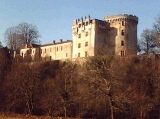
La Chapelle-Faucher
Encyclopedia
La Chapelle-Faucher is a commune
in the Dordogne
department in Aquitaine
in southwestern France
.
This small but quaint rural French village has a romanesque style church, Notre Dame de l'Assomption built in the 12th century, a rambling ancient chateau overlooking the Cole River built in the 13th century (some of which has been restored and used for wedding receptions and other events), a kindergarten and a town hall. La Chapelle-Faucher is set above the river Côle
, a tributary of the Dronne
river which runs through the nearby town of Brantôme
.
. The village was gradually rebuilt, but religion's powerful hand frequented the village. On 2 July 1569, Protestants led by Gaspard de Coligny, rounded up 260 Catholic peasants (men, women and children), put into the chateau and brutally killed one by one during the wars of religion
. The local priest pleaded that they be saved but to no avail. According to the local chronicler of these wars at the time, Pierre de Bourdeille, seigneur (and abbé) de Brantôme, the killings began at 9am and finished around 2pm. Some residents say you can hear the voices of distressed peasants in the darkness of the night...
Communes of France
The commune is the lowest level of administrative division in the French Republic. French communes are roughly equivalent to incorporated municipalities or villages in the United States or Gemeinden in Germany...
in the Dordogne
Dordogne
Dordogne is a départment in south-west France. The départment is located in the region of Aquitaine, between the Loire valley and the High Pyrénées named after the great river Dordogne that runs through it...
department in Aquitaine
Aquitaine
Aquitaine , archaic Guyenne/Guienne , is one of the 27 regions of France, in the south-western part of metropolitan France, along the Atlantic Ocean and the Pyrenees mountain range on the border with Spain. It comprises the 5 departments of Dordogne, :Lot et Garonne, :Pyrénées-Atlantiques, Landes...
in southwestern France
France
The French Republic , The French Republic , The French Republic , (commonly known as France , is a unitary semi-presidential republic in Western Europe with several overseas territories and islands located on other continents and in the Indian, Pacific, and Atlantic oceans. Metropolitan France...
.
This small but quaint rural French village has a romanesque style church, Notre Dame de l'Assomption built in the 12th century, a rambling ancient chateau overlooking the Cole River built in the 13th century (some of which has been restored and used for wedding receptions and other events), a kindergarten and a town hall. La Chapelle-Faucher is set above the river Côle
Côle
The Côle is a long river in the Dordogne département, south-central France. Its source is near le Châtenet, a hamlet in Firbeix. It flows generally southwest...
, a tributary of the Dronne
Dronne
The Dronne is a 201 km long river in southwestern France, right tributary of the Isle River. Its source is in the north-western Massif Central, east of the town of Châlus at an elevation of 510 m...
river which runs through the nearby town of Brantôme
Brantôme, Dordogne
Brantôme is a commune in the Dordogne department in southwestern France.It is the seat of the canton of Brantôme. Via Lemovicensis, an ancient Roman Road runs through Brantôme...
.
History
In the 14th century the entire town was burnt to the ground during the Hundred Years' WarHundred Years' War
The Hundred Years' War was a series of separate wars waged from 1337 to 1453 by the House of Valois and the House of Plantagenet, also known as the House of Anjou, for the French throne, which had become vacant upon the extinction of the senior Capetian line of French kings...
. The village was gradually rebuilt, but religion's powerful hand frequented the village. On 2 July 1569, Protestants led by Gaspard de Coligny, rounded up 260 Catholic peasants (men, women and children), put into the chateau and brutally killed one by one during the wars of religion
French Wars of Religion
The French Wars of Religion is the name given to a period of civil infighting and military operations, primarily fought between French Catholics and Protestants . The conflict involved the factional disputes between the aristocratic houses of France, such as the House of Bourbon and House of Guise...
. The local priest pleaded that they be saved but to no avail. According to the local chronicler of these wars at the time, Pierre de Bourdeille, seigneur (and abbé) de Brantôme, the killings began at 9am and finished around 2pm. Some residents say you can hear the voices of distressed peasants in the darkness of the night...

